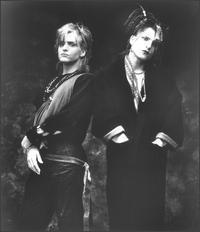
Gene Loves Jezebel
by John BushTwin brothers Jay and Michael Aston began playing music in 1980 when they formed Slav Arian with guitarist Ian Hudson and a drum machine. Though the Astons grew up in Porthcawl, South Wales, they moved to London in 1981 and renamed the goth-influenced group Gene Loves Jezebel. The trio played several live shows and was quickly signed by Situation 2. In May 1982, the label released Gene Loves Jezebels demo single, Shavin My Neck. The band then added bassist Julianne Regan and drummer Dick Hawkins. Regan left soon after to form All About Eve, leaving Ian Hudson and Michael Aston to alternate on bass until Peter Rizzo joined in 1984. Hawkins also split for a time — replaced by John Murphy and later Steve Goulding — but returned in 1983.Gene Loves Jezebel released two more singles in 1983 before their debut album, Promise, hit number one in the U.K.s indie charts. In 1984, the group recorded a John Peel radio session for BBC and toured America with John Cale. After returning to England, Gene Loves Jezebel released the singles Influenza (Relapse) and Shame (Whole Heart Howl), but then waited a full year before second album Immigrant appeared in mid-1985. (Its not very surprising that the album was recorded with a lineup change, this time drummer Marcus Gilvear instead of Dick Hawkins.) Immigrant also hit number one on the indie charts, but during a tortured American tour, founding member Hudson left, and was replaced by former Generation X guitarist James Stevenson.The year 1986 brought a contract with Beggars Banquet and, subsequently, popular-chart success for the group. Sweetest Thing hit the Top 75 in England, and the resulting album, Discover (which included a limited-edition live album called Glad to Be Alive), reached the expected indie-chart top spot and also did well with college radio in America. Chris Bell became the bands fifth drummer later that year, and Gene Loves Jezebels fourth album, The House of Dolls, was released late in 1987, yielding a single, The Motion of Love, that grazed the U.S. charts. The Astons turned their attention to dance with the single Heartache, but Michael decided to leave the band by mid-1989.In a small twist of fate, Gene Loves Jezebel gained its highest-charting American single the following year, when Jealous, the major single from Kiss of Life, reached number 68 in August 1990. Two years later, Jay Aston and co. released Heavenly Bodies, which did well in Europe and on American college radio; the groups American label folded one year later though, and after a few sporadic live shows, Gene Loves Jezebel called it quits.As early as 1992, Michael Aston had been working with a new band called the Immigrants. Two years later, he re-formed the band as Edith Grove and released a self-titled album. Michael and Jay began working together again that same year, and later recorded two songs with Stevenson, Bell, and Rizzo for a GLJ best-of compilation, released in September 1995. While Jay performed occasional acoustic shows under his own name, Michael played with members of Scenic and released a solo album, Why Me Why This Why Now, in 1995. Gene Loves Jezebel re-formed in 1998 for VII, released in 1999 on Robinson Records. It was followed that same year by both Love Lies Bleeding and Live in the Voodoo City. Giving Up the Ghost appeared in early 2001. The two-disc Anthology, Vols. 1 & 2 arrived in 2006.\r
